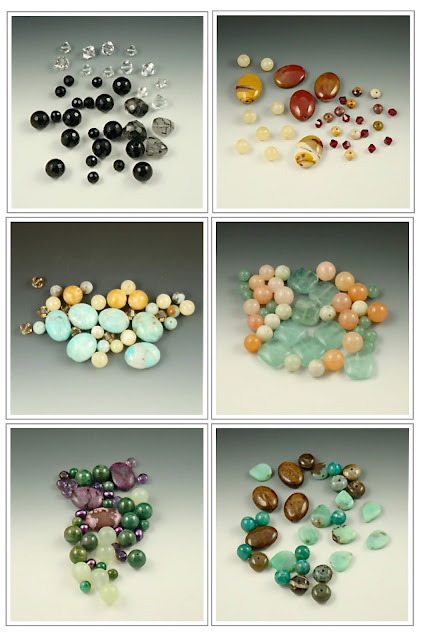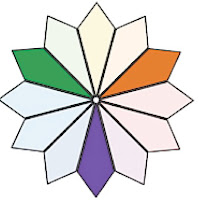Our previous post talked about the color wheel and how color is an important aspect of design. At Kerry Elizabeth our main material are gemstones, freshwater pearls, and swarovski crystal. We have put together a few color stories to get you inspired.
Thursday, February 24, 2011
Tuesday, February 22, 2011
Spring 2011 Color Forecast
I'm sure I'm not the only one who is ready for spring! I'm ready to put those dark colors away. Although we may still have a few weeks to go, I had to take a peak at the spring 2011 color forecast.
Year and year, PANTONE announces the seasons colors. Designers in multiple industries, from fashion to technology, use the colors as a guideline. Here are colors that PANTONE predicted for this upcoming spring.
Citing exotic destinations like Africa, India, Peru and Turkey as inspiration for spring 2011, designers continue to satisfy consumers’ need to escape everyday challenges with intriguing color combinations that transport them to foreign lands.
 |
| Pantone Spring 2011 Color Forecast |
Flirtatious Honeysuckle is a feel-good hue that brings a festive sense of playfulness to this season’s palette. This vibrant pinkish-red for both apparel and cosmetics makes consumers eel alive, and is a perfect post-winter pick-me-up.
Spicy, gregarious and persuasive describe Coral Rose, a sophisticated orange that, much like Beeswax, a warm, honeyed yellow, conjures up feelings of faraway lands and locales. Pair either of these piquant hues with a cool, refreshing color-wheel opposite like Regatta for a vibrant color combination that will add zest to any wardrobe. Romantic, fanciful Lavender implies sensuality with its subtle hint of red undertone. Combine it with Beeswax or Coral Rose for a unique counterpoint.
Alluring Blue Curacao evokes thoughts of tropical destinations and pays homage to the 2010 Color of the Year, Turquoise. Practical consumers can continue to incorporate enticing Caribbean blues into spring by pairing Blue Curacao with
warm, complementary colors like Honeysuckle or Coral Rose. Peapod, a fresh yellow-green, brings an organic element to the palette and is reminiscent of the green shoots that signify change and new beginnings traditionally found in spring.
Trans-seasonal neutrals ground this season’s palette and provide a stable backdrop for all the other colors. The so-called “nude hues” are represented in the range of ethereal Silver Peony to dramatically deep Russet. Another dependable background color, Silver Cloud, is the quintessential neutral that consumers can rely on to coordinate with everything in their closet.
For more information on PANTONE and the spring 2011 color forecast visit www.pantone.com/spring2011.
Thursday, February 17, 2011
The Art of the Color Wheel
Color has always been the main focus of my jewelry designs. Mixing and matching different colors can drastically effect the overall concept. From decorating your home to selecting an outfit, color should be considered.
Here's a look at the color wheel created by Johannes Itten that might have you looking at color a bit differently.
How the Color Wheel Works
Creative use of color has always been a hallmark of artists and skilled craftspeople. The Color Wheel lets you use basic color theory by quickly and easily determining each type of color relationship. Johannes Itten developed the perfect visual tool: a 12-color wheel. With his color wheel, it is fun and easy to develop color schemes that work.
The wheel starts with the three primary colors equidistant from each other: yellow, red and blue.
Mixing two primaries creates a secondary color. The three secondaries are: orange, violet and green.
Mixing a primary color with a nearby secondary color yields a tertiary color. The six tertiaries are: yellow-orange, red-orange, red-violet, blue-violet, blue-green and yellow-green.
Four Color Schemes
Monochromatic Scheme: The most simple way to create a beautiful piece is to use the same color throughout, but by using lighter and darker elements. Shown are various shades and tints of green.
Analogous Scheme: Always pleasing to the eye are colors that are close to each other on the wheel, like yellow to orange to red-orange.
Complementary Scheme: Nothing stirs excitement like the eye candy, high contrast effect of a complementary color scheme. Complementary colors are directly opposite each other on the color wheel and are always stimulating if their hues are pure. A beautiful, more subdued harmony can be achieved by using light or dark complementary pairs.
Split-Complementary Scheme: This scheme combines the effect of the powerful complementary scheme with a variation on the analogous scheme. It offers intriguing possibilities in complexity and sophistication. Determine a key color. Then go directly across the color wheel to find its complement. Instead of the complement, use the two colors that you find next to it. In this example the key color is green. Instead of green's complement (red), its split-complements were chosen: red-orange and red-violet.
Friday, February 11, 2011
Jewelry Marking 101 Sneak Peek
Kerry Elizabeth is hosting a beginners jewelry making class Sunday, February 13th at 2:00 PM. Here's a sneak peek at what you're in for!
 |
|
 |
|
 |
|
Need some more inspiration? We have created jewelry kits filled with gemstones and findings in an array of color stories.
Stop by Penn's Place at 206 Delaware St in Historic New Castle, DE on February 13th at 2:00 PM. Bring your ideas and we will supply the rest!
Wednesday, February 9, 2011
"Green" Jewelry Care Tip
The fantastic jeweler Faulkner Jewelry Design from Middletown, DE posted a great jewelry tip in the February newsletter that I just had to pass along.
 This month's tip illustrates a "green" way to Reuse, rather than Reduce or Recycle. Do you have one earring from a favorite pair? Has it's wayward mate disappeared unexpectedly from sight? Is it lost in your car, purse, or caught in your scarf or hair?
This month's tip illustrates a "green" way to Reuse, rather than Reduce or Recycle. Do you have one earring from a favorite pair? Has it's wayward mate disappeared unexpectedly from sight? Is it lost in your car, purse, or caught in your scarf or hair?Here's an idea to make use of the orphan earring. Use jewelry pliers to detach the lone earring from the earwire (the part that goes through your ear) and set the ear wire aside. Then thread the loop at the top of the earring into a small chain, ribbon, or silk cord. If you use a ribbon or silk cord, just tie it behind your neck. If you find that loop at the top of the earring is too small to thread over the closures on the chain, you may need to add a small ring, called a jump ring.
And now you know a simple way to reuse that lone earring!
Visit Faulkner Jewelry Design at their two studio locations or visit them at www.faulknersterlingdesign.com.
115 E. Redding St
Middletown, DE 19709
Penn's Place, Studio 2
206 Delaware St
New Castle, DE 19720
Monday, February 7, 2011
Love is in the Air
As you may already be aware, every gemstone is unique and represents a different type of healing power, energy, or luck. There are also many love gemstones. I have compiled six stones that will boost your relationships and your love life.
 |
| Rose Quartz |
2. Lapis represents tenderness, sympathy and love. Those using the stone will be known by their powers of love and affection and can generally win over others through the powers of love. They would also find that they can transmit love to others with ease and confidence.
3. Kunzite opens the heart to all forms of love. It can also be a sign of new life and is sometimes regarded as a symbol for pregnancy.
 |
| Rainbow Moonstone |
5. Sapphire has long symbolized truth, sincerity, and faithfulness.
6. Moonstone is called the gem of hope. It can bring success in both love and business matters.
Thursday, February 3, 2011
A Jewelry Shopper's Checklist
Wether you are treating yourself or a special someone to a new piece of jewelry it is important to shop around. Compare price, quality, and customer service. Use the checklist below when shopping.
- Shop with companies you know or do some homework to make sure the company is legitimate.
- Ask about the return policy before you buy.
- Check for the appropriate markings on metal jewelry.
- Ask whether the pearls are natural, cultured or imitation.
- Ask whether a gemstone is natural, laboratory-created or imitation.
- Make sure the sales receipt includes any information you relied on when making your purchase such as the gem’s weight or size.
Tuesday, February 1, 2011
A Guide to Buying Gemstone Jewelry
Gemstones are found throughout world from the earth to the sea. Once the gems are cut and polished they can be made into the jewelry you have come to recognize. Take a look at the factors that make a gem rare and valuable.
As with diamonds, gemstones are classified by the 4 C’s: color, carat, cut, and clarity.
1. Color is typically the most important value-setting factor for gemstones. All gems have a preferred color or a relatively small range of preferred colors. The more the color varies from this range—lighter or darker, more vivid or less—the less valuable the stone.
Color is composed of three dimensions: hue, tone, and saturation.
- Hue refers to the impression of color usually noticed immediately, such as red, yellow, or blue.
- Tone refers to the degree of lightness or darkness of an object.
- Saturation defines the degree of purity of a hue.
2. Cut refers to the shape or design of a stone, arrangement of facets, as well as the precision of the stone's proportions and finish. The cutting process reveals the beauty of a gem.
Gemstones are cut into shapes we are familiar with such as oval, emerald, pear, round, and marquise. In addition, they can be carved or fashioned into almost any design imaginable. Proportions involve the balance and appeal of the basic design. Finish refers to the detail of the workmanship. A well-proportioned cut with a fine finish will show a stone's optical properties to its fullest potential. When all other factors are even (color, clarity, and carat weight), a better-cut gem will be more valuable.
 3. Carat refers to the weight of a gemstone. One carat, the traditional unit of measurement for gemstones, is equal to approximately 0.2 grams. You may also hear the weight of a gemstone referred to in points. A point is equal to 1/100 of a carat; therefore a 75-point gemstone equals 0.75 carat.
3. Carat refers to the weight of a gemstone. One carat, the traditional unit of measurement for gemstones, is equal to approximately 0.2 grams. You may also hear the weight of a gemstone referred to in points. A point is equal to 1/100 of a carat; therefore a 75-point gemstone equals 0.75 carat.Two different gemstones may have the same dimensions but different weights. This is due to the specific gravity or density of the gem mineral. This difference can help gemologists identify a gemstone.
Up to a certain point, the larger a stone is, the more rare it is and the higher the price it will command. For stones that commonly occur in larger sizes, the value may decrease if the gem reaches a size that makes it impractical for jewelry use.
4. Clarity refers to the evaluation of a gemstone's internal characteristics. These characteristics include inclusions, which lie within the stone, or blemishes, which lie on the surface of a gem. The fewer clarity characteristics, the more rare the gemstone.
Each variety of gemstone has its own clarity standards. For example, Tanzanite is virtually inclusion-free, while Emerald almost always contains clarity characteristics. For this reason, Gemological Institute of America's grading system divides transparent colored gemstones into three clarity types. This allows gems to be more evenly evaluated as it takes into account the individual nature of each gemstone.
Subscribe to:
Comments (Atom)








